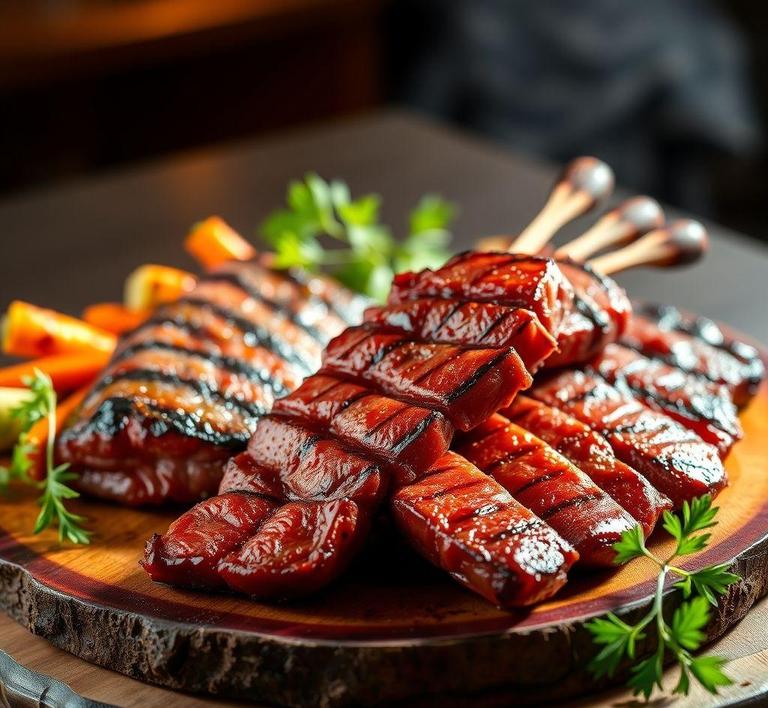So, you’ve got some leftover BBQ meat after that epic grilling session-lucky you! But now, you’re wondering, can you refreeze it and still enjoy it later? Well, good news! Refreezing BBQ meat is totally possible, but there are a few things to keep in mind to make sure it stays just as tasty when you heat it up again. In this guide, we’ll walk you through the best practices for safely refreezing your leftover BBQ without compromising on flavor or texture, so you can enjoy that smoky goodness another day!
Can You Refreeze BBQ Meat?

Refreezing BBQ meat is a question that often pops up after a delicious barbecue or family cookout, especially when leftovers remain. The simple answer is that yes, you can refreeze BBQ meat, but with some important considerations to ensure it remains safe to eat and still tastes good when you decide to thaw and enjoy it again. However, the process isn’t as straightforward as just popping it back into the freezer. Several factors influence whether refreezing BBQ meat is a good idea, such as how the meat was initially cooked, stored, and how long it’s been out at room temperature.
To begin with, it’s crucial to understand the freezing and thawing process itself. When BBQ meat is frozen, the water inside the meat forms ice crystals. During the first freeze, the structure of the meat changes slightly, and upon thawing, moisture is lost, which can affect the texture and taste. When you refreeze meat, especially if it’s been thawed slowly, this process is repeated, which can cause further changes in the texture and flavor of the BBQ meat.
One key consideration is food safety. If BBQ meat has been sitting out at room temperature for more than two hours, it is not safe to refreeze it. Bacteria thrive in the "danger zone" between 40°F and 140°F (4°C – 60°C), so allowing meat to sit too long increases the risk of foodborne illness. The general rule is to never refreeze cooked food that has been left out too long, as it can result in potential contamination.
Another consideration is how well the BBQ meat was initially cooled before being placed in the freezer. Rapid cooling is essential in reducing bacterial growth. If the meat was stored improperly after cooking and left in warm conditions for a prolonged period, it’s best to avoid refreezing it.
How To Refreeze BBQ Meat?
Refreezing BBQ meat successfully requires careful attention to how it was prepared, stored, and handled. If done properly, you can extend the enjoyment of those smoky, tender flavors. Here’s a step-by-step guide on how to do it:
-
Cool the BBQ Meat Quickly:
The first step is to ensure the BBQ meat is cooled promptly after cooking. If possible, place the meat in shallow containers so that it can cool down quickly. The faster you get the meat from hot to cold (preferably below 40°F or 4°C within two hours), the better. This reduces the risk of bacterial growth and helps maintain the quality when refrozen.
-
Store in Airtight Packaging:
For best results, store your leftover BBQ meat in airtight containers or freezer bags. Wrap it tightly in foil or plastic wrap before placing it in a resealable freezer bag. This helps minimize freezer burn, a condition where the meat dries out due to exposure to air, which can compromise both texture and flavor.
-
Label and Date:
Before you toss it into the freezer, be sure to label the packaging with the date. It’s easy to forget how long the BBQ meat has been frozen, and knowing the date helps ensure you consume it within a reasonable time frame. For the best taste and texture, it’s advisable to eat refrozen BBQ meat within 2-3 months.
-
Avoid Refreezing Multiple Times:
Each time BBQ meat is thawed and refrozen, its quality declines. The texture becomes mushier, and the flavor loses its richness. To maintain the best quality, it’s best to only freeze BBQ meat once. Plan your portions so that you’re only defrosting what you plan to eat.
-
Defrosting the Right Way:
When you’re ready to enjoy your refrozen BBQ, never defrost meat at room temperature. Instead, place it in the fridge overnight or use the microwave’s defrost setting. Slow defrosting helps maintain moisture and flavor. If you’re in a hurry, the microwave or stovetop method can also work, but be careful not to overcook it.
Quality Impact
Refreezing BBQ meat does impact its quality, particularly when it comes to texture and moisture retention. The initial freezing process can cause the cells in the meat to break down, leading to some loss of juiciness and tenderness when the meat is thawed. When refreezing, these changes are compounded, and the texture may become drier or tougher, especially in lean cuts of meat like chicken breast or pork loin.
One of the most noticeable changes will be in the flavor. BBQ meat typically has a smoky, charred, and tender quality that comes from the grilling or slow-cooking process. When refrozen, the flavors may not be as bold or vibrant. This is because some of the fat and juices-those that give BBQ meat its distinctive richness-are lost in the freezing and thawing process.
Additionally, freezer burn can occur if the meat is improperly sealed or stored for a long period. Freezer burn happens when air gets into the packaging, causing the meat’s surface to dry out and turn discolored. While freezer-burned meat is still safe to eat, it will have a less appetizing texture and flavor.
Despite these potential impacts, fatty cuts of BBQ meat-like brisket, ribs, or pulled pork-tend to fare better than leaner cuts after being refrozen. Fat acts as a barrier against the loss of moisture and can help maintain the texture even after freezing and refreezing.
Is It Safe To Refreeze BBQ Meat?
When it comes to refreezing BBQ meat, safety is the foremost concern. The short answer is: it depends. Refreezing meat is not inherently unsafe, but certain conditions must be met to prevent the risk of foodborne illness and maintain the quality of the meat.
BBQ meat, like any cooked meat, contains moisture and proteins that can harbor bacteria if not handled properly. The key factor in determining safety is how the meat was thawed and how long it stayed at temperatures that promote bacterial growth (typically between 40°F and 140°F, often called the "danger zone").
If BBQ meat was thawed in the refrigerator and has not been left out at room temperature for more than two hours, refreezing it is generally safe. The cold environment keeps bacteria dormant. However, if the meat was thawed using quicker methods such as on the countertop, in warm water, or in a microwave, it may have spent too much time at unsafe temperatures, increasing bacterial growth risk. In these cases, refreezing is unsafe unless the meat is thoroughly cooked again.
It’s also important to note that each freeze-thaw cycle affects the meat’s texture and moisture. Refreezing can cause ice crystals to form inside the meat cells, rupturing them and leading to a drier, tougher final product when reheated. So, while it can be safe, the quality will likely suffer.
Signs That BBQ Meat Should Not Be Refrozen
Recognizing when BBQ meat should not be refrozen is crucial to avoid foodborne illnesses and unpleasant eating experiences. Here are telltale signs:
- Off Smell: One of the most obvious indicators is a sour, rancid, or ammonia-like smell. This suggests bacterial spoilage or the onset of decay.
- Slimy or Sticky Texture: Spoiled meat often develops a slimy film or sticky surface due to bacterial activity breaking down proteins.
- Discoloration: While BBQ meat can naturally brown due to cooking and smoke, greenish or gray patches are a red flag.
- Left Out Too Long: Meat that has been sitting at room temperature for more than two hours (or one hour in hot climates) should never be refrozen.
- Previously Frozen and Left at Unsafe Temps: If BBQ meat was thawed for more than a day or has been repeatedly thawed and partially cooked, it’s safer to discard it.
- Mold: Any visible mold growth is a strict ‘no’ for refreezing.
In essence, if the meat shows any of these signs, don’t take the risk-it’s better to dispose of it than to compromise health.
Common Refreezing Mistakes
When handling BBQ meat, many people make mistakes that either jeopardize safety or degrade food quality:
- Refreezing Meat Left Out Too Long: One of the biggest errors is refreezing meat that’s spent too long in the danger zone. Bacteria multiply rapidly in this temperature range, increasing the risk of food poisoning.
- Refreezing Without Proper Cooling: Putting hot BBQ meat directly into the freezer can raise the freezer’s temperature, potentially thawing other foods and creating an unsafe environment.
- Refreezing Multiple Times: Each freeze-thaw cycle diminishes meat quality. Some people repeatedly thaw and refreeze leftover BBQ, which results in mushy, dry meat with a loss of flavor.
- Improper Storage: Using containers or bags that aren’t airtight can lead to freezer burn, where dehydration ruins the texture and taste of the meat.
- Not Labeling: Forgetting to date and label the meat before refreezing can lead to keeping it for too long, increasing spoilage risk.
Tips And Tricks
To safely refreeze BBQ meat and maintain the best quality, keep these helpful tips in mind:
- Cool Before Freezing: Let BBQ meat cool to room temperature within two hours (preferably one hour in summer). Ideally, place it in shallow containers to cool evenly before freezing.
- Freeze in Portions: Divide meat into meal-sized portions before freezing. This minimizes thawing and refreezing, preserving taste and texture.
- Use Airtight Packaging: Vacuum seal or use high-quality freezer bags to prevent freezer burn and maintain moisture.
- Label Clearly: Mark the date and contents to track freshness. Use refrozen BBQ meat within 1-2 months for optimal quality.
- Thaw Properly: Always thaw BBQ meat in the fridge, never on the counter. Alternatively, use the defrost setting on a microwave if cooking immediately.
- Reheat Thoroughly: When reheating refrozen BBQ, heat the meat evenly to an internal temperature of 165°F (74°C) to kill any potential bacteria.
- Consider Repurposing: If texture is a concern, use refrozen BBQ meat in dishes like stews, chili, or casseroles, where it can reabsorb moisture and flavors.
Conclusion
Refreezing BBQ meat can be safe, but it requires careful attention to food safety principles. If meat is thawed properly and has not lingered in the danger zone, you can refreeze it with minimal risk. However, the quality will invariably decline with each freeze-thaw cycle, leading to drier and less flavorful meat.
Always check your meat for signs of spoilage before refreezing, avoid common mistakes like refreezing meat left out too long or without cooling, and use airtight storage and proper labeling to extend shelf life. By following these guidelines and tips, you can safely enjoy your delicious BBQ leftovers without compromising health or taste.


